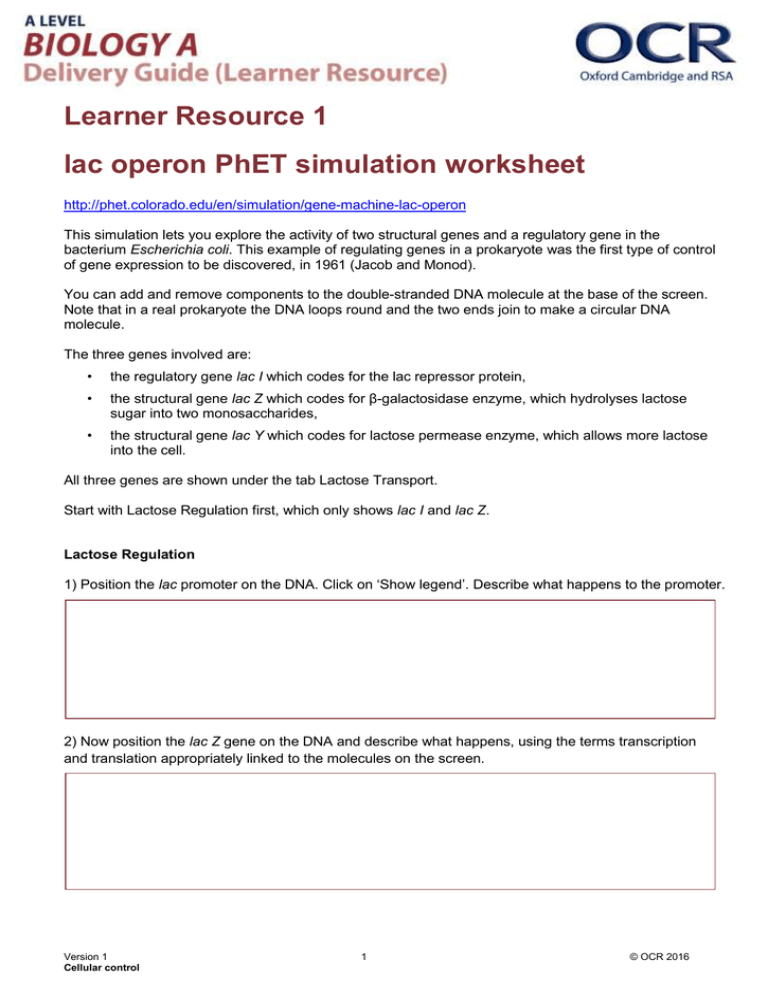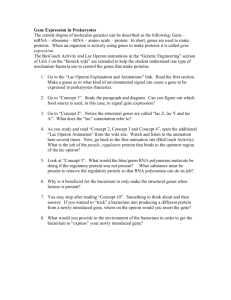Learner Resource 1 lac operon PhET simulation worksheet
advertisement

Learner Resource 1 lac operon PhET simulation worksheet http://phet.colorado.edu/en/simulation/gene-machine-lac-operon This simulation lets you explore the activity of two structural genes and a regulatory gene in the bacterium Escherichia coli. This example of regulating genes in a prokaryote was the first type of control of gene expression to be discovered, in 1961 (Jacob and Monod). You can add and remove components to the double-stranded DNA molecule at the base of the screen. Note that in a real prokaryote the DNA loops round and the two ends join to make a circular DNA molecule. The three genes involved are: • the regulatory gene lac I which codes for the lac repressor protein, • the structural gene lac Z which codes for β-galactosidase enzyme, which hydrolyses lactose sugar into two monosaccharides, • the structural gene lac Y which codes for lactose permease enzyme, which allows more lactose into the cell. All three genes are shown under the tab Lactose Transport. Start with Lactose Regulation first, which only shows lac I and lac Z. Lactose Regulation 1) Position the lac promoter on the DNA. Click on ‘Show legend’. Describe what happens to the promoter. 2) Now position the lac Z gene on the DNA and describe what happens, using the terms transcription and translation appropriately linked to the molecules on the screen. Version 1 Cellular control 1 © OCR 2016 3) Use the manual lactose injector to add some lactose to the cell. Small quantities of lactose can be absorbed by the bacterium from the agar medium or other food it is growing on. Explain the role of the gene product of the lac Z gene in metabolizing lactose in a bacterium. Relate your answer to respiration. 4) With only the lac promoter and lac Z gene in position on the DNA, β-galactosidase enzyme is made all the time, even if the cell is not taking up any lactose. Suggest why this would be a disadvantage to a bacterial cell. 5) Introduce the lac operator, the regulatory gene lac I and its lac I promoter to the system. The parts of the DNA that act as control elements are now in place. With no lactose present, describe what happens to the transcription of the lac Z gene. 6) Now add some lactose. How does this affect transcription of the lac Z gene? Version 1 Cellular control 2 © OCR 2016 7) Wait till the lactose is hydrolysed and describe how the lac Z gene is switched off again. 8) Switch screens to the Lactose Transport tab. Place all the genes, promoters and operator onto the DNA. Describe what happens when lactose is added and explain the role of the protein product of the lac Y gene. Further Research: 9) Explain what is meant by the terms structural gene and regulatory gene. 10) What does the word operon mean and why is the operon arrangement beneficial to the bacterium? Version 1 Cellular control 3 © OCR 2016

![Lac Operon AP Biology PhET Simulation[1]](http://s3.studylib.net/store/data/006805976_1-a15f6d5ce2299a278136113aece5b534-300x300.png)

